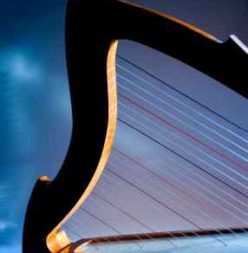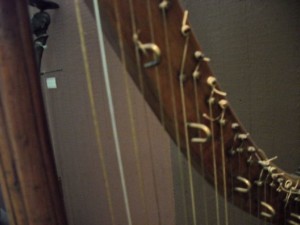Before I talk about the lever harp and key signatures, it might be interesting to think about why the technology of levers evolved at all. The picture above is close-up of an antique harp in a museum in Europe. See those funny hooks near some of the strings? Those are early levers, awkward little beasts that required twisting.
The idea then was the same as it is now: by putting pressure on a string, pinching if off against the neck of the harp, one can shorten it. Shorter strings vibrate at a higher pitch, so we can thus create a “sharp”, for example, changing the F string to F#. Doing this changes a harp from a strictly diatonic instrument (one which can play in only one key at a time, without any accidentals), into a much more versatile instrument.
However, hooks and early levers were not only difficult to use but not terribly accurate. Yay for the luthiers who persevered over the course of the twentieth century to give use workable, accurate sharping levers! Modern levers are little marvels, allowing smooth changes and allowing the strings to ring true even when “pinched”.
Nowadays, most levers harpers, once they’ve cut their teeth on the first method book and endlessly plumbed the depths of the key of C, find music in other keys that they wish to play. Perhaps you have reached this crossroads yourself?
As long as you still tune your harp in the key of C (with the levers down), you are stuck with keys going in only one direction: up. This means sharps–and keys that use sharps–are the only next option. Unless, of course, you start retuning your harp with flats, in which case you gain the versatility of one or more flat keys.
How is this possible? On the simplest level, if you tune strings flat, you use some of the levers to create “naturals”. You still raise levers, they still raise the pitch of the strings, but because the strings were flat to begin with, you are not creating sharps (that would require levers that pull up the pitch twice, which is why the pedal harp evolved . . . but that’s another story).
If you would like to begin to learn more about tuning your harp in flats (specifically, the key of Eb), you can read this. If you would like to read about it in greater depth, I have created a free pdf about the lever harp and key signatures that takes you through the process of working from the key of Eb all the way to the key of E, lever by lever. Along the way, you will be introduced to (or become reacquainted with) key signatures and the circle of fifths. If you follow along on your harp a few times and fill in the worksheets, you will not only start to understand the theory better, but also become more confident that you can put it to good use. You’ll find the free pdf at the bottom of this post.
By the way, if you would like personal help with this or are otherwise ready to take your harp learning to a completely new level, I currently have a few openings for students (no waiting list for in-person or Skype lessons!).
You can also visit my studio site and read reviews from other students. Please contact me right away if you want to be encouraged and inspired.
Download your pdf here:
The Lever Harp & Key Signatures


Thank you Susan for all the hard work that you put into your site and the information that you share . I really enjoy reading them every time you post one.
Hope that you are well .
Carla ?
Hi, Carla! Great to hear from you, and thanks for the encouragement!
Susan